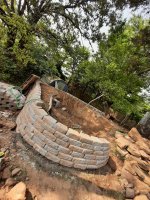- Joined
- Sep 10, 2021
- Messages
- 6
- Reaction score
- 1
- Country

Hi, y'all. I'm following advice from another thread: posting my project to solicit feedback and guidance. I didn't mean to be nose-deep in this project, but my step-father brought a backhoe over at 9:30 one night to help redistribute a few inches from one side of the existing, small koi pond to the other side, where the soil had eroded below the water level. I blinked, and suddenly there was a 12' diameter, 6' deep hole in my yard.
I rolled with it.
The old liner obviously no longer fits. I was not prepared for this situation financially, so I'm diligently keeping the money cost minimal -- without taking the kind of shortcuts I'll regret later. A local pool store gave me a brand new pool liner pulled out of a new pool that didn't fit, and they will call me later this month when they have another one.
The liner is about 15'x20'. I do not expect it will cover the entire surface area, but should get very close. I have pvc adhesive to join it together with the second piece once that's available. The liner is 27 mil. I'm removing rocks by hand, and adding sand prior to putting the liner down.
I'm building two circles, planning for a future pond renovation. The second circle (partial retaining wall tangential in photo) will have raised vegetable garden beds around the sides for now, which eventually may form a step/sitting area underwater. One pond would be the filtration plant pond at that point, while the other becomes a hot tub.
My step-father is coming back with the backhoe this weekend. I'm taking steps to plan more carefully and direct his contributions more effectively this time. There is a small hole in the retaining wall where a 3/4" pvc drain pipe could be placed, but I'll need to dig up the dirt to place it there, then put the dirt back, water it, and pack it with the backhoe to settle. I have a ball valve for that size pipe. Eventually perhaps a pump would be connected there to move water from the swimming area to the filtration area.
I've never done anything like this. Your insight and encouragement is greatly appreciated.
I rolled with it.
The old liner obviously no longer fits. I was not prepared for this situation financially, so I'm diligently keeping the money cost minimal -- without taking the kind of shortcuts I'll regret later. A local pool store gave me a brand new pool liner pulled out of a new pool that didn't fit, and they will call me later this month when they have another one.
The liner is about 15'x20'. I do not expect it will cover the entire surface area, but should get very close. I have pvc adhesive to join it together with the second piece once that's available. The liner is 27 mil. I'm removing rocks by hand, and adding sand prior to putting the liner down.
I'm building two circles, planning for a future pond renovation. The second circle (partial retaining wall tangential in photo) will have raised vegetable garden beds around the sides for now, which eventually may form a step/sitting area underwater. One pond would be the filtration plant pond at that point, while the other becomes a hot tub.
My step-father is coming back with the backhoe this weekend. I'm taking steps to plan more carefully and direct his contributions more effectively this time. There is a small hole in the retaining wall where a 3/4" pvc drain pipe could be placed, but I'll need to dig up the dirt to place it there, then put the dirt back, water it, and pack it with the backhoe to settle. I have a ball valve for that size pipe. Eventually perhaps a pump would be connected there to move water from the swimming area to the filtration area.
I've never done anything like this. Your insight and encouragement is greatly appreciated.




